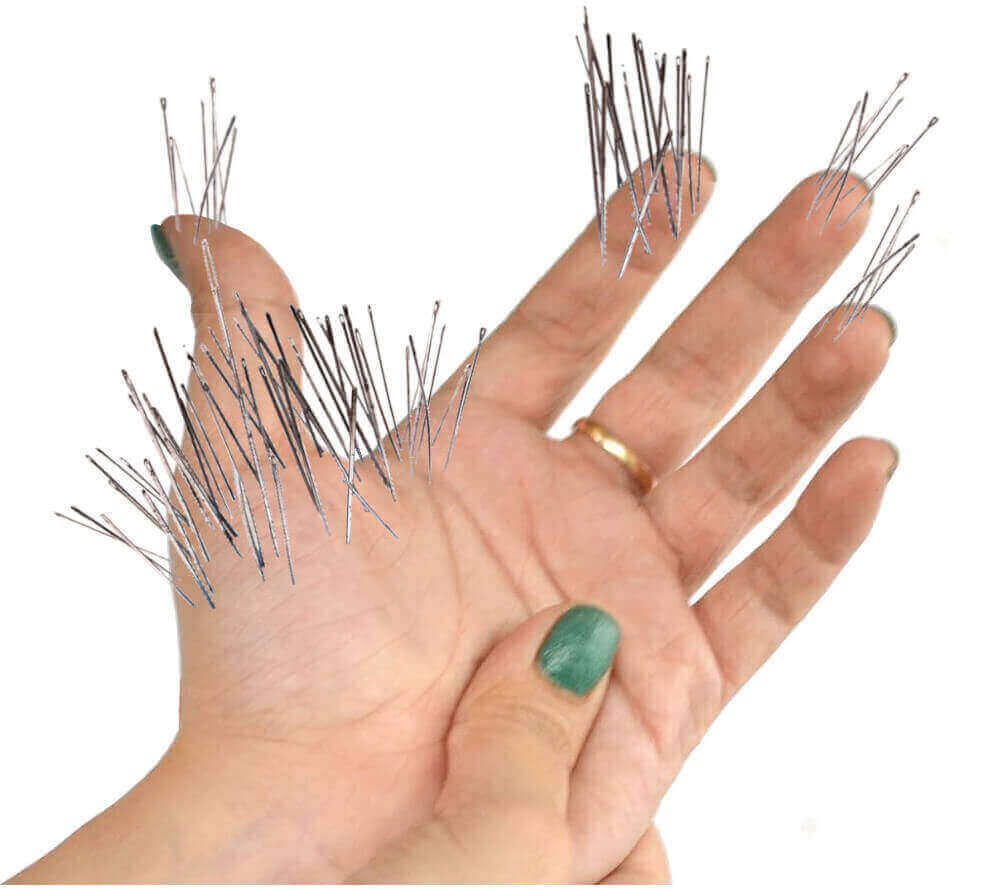Carpal Tunnel Syndrome Signs
From Dr. Z - Carpal tunnel syndrome specialist
Signs of Carpal Tunnel or Tendonitis?
Can you tell whether you have carpal tunnel or tendonitis? Actually, tendonitis and carpal tunnel syndrome signs and symptoms are very similar. So you're in the majority if you can't tell the difference.
Sometimes the signs and symptoms of these disorders fool some doctors into making the wrong diagnosis. That's because the two conditions are also similar in how they occur (i.e., repetitive stress).
Most importantly, carpal tunnel syndrome is relatively difficult to treat, especially in its later stages. In contrast, wrist flexor tendonitis is relatively easy to treat - usually with simple rest.
- FIND OUT: do you have carpal tunnel?
No strings attached self-test.
Other conditions have similar signs
Do you live with hand pain every day? Maybe you have tingling, burning, aching or numbness in your fingers, too. These are all hallmark carpal tunnel syndrome signs. But they can also mean you have wrist flexor tendinitis instead.
Carpal tunnel syndrome is more serious than tendonitis. And it's harder to treat. So knowing how to identify the symptoms of carpal tunnel is the first step in tackling the disorder. Only then can you properly treat it.
Other conditions also have similar signs and symptoms. In fact, de Quervain’s tenosynovitis is often confused as wrist tendonitis. But de Quervain’s tenosynovitis only affects the thumb tendons.
Carpal tunnel syndrome and wrist flexor tendonitis are medically different conditions. But their symptoms can be almost identical. That’s because they share a common factor; they're both caused by tendon inflammation.
Scientists believe that either condition comes from repetitively stressing your hand. That's why these disorders are classified as repetitive stress injuries.
As a result of the stress, tendons inflame and swell. But the similarities between carpal tunnel syndrome, wrist tendonitis, and de Quervain’s tenosynovitis end there.
What distinguishes these conditions is:
- what causes the symptoms to appear
- when you notice them
- how the conditions are treated
It should be noted that every person is different and will experience symptoms and warning signs differently. Also, certain symptoms overlap from one condition to the other.
And YES! You could have both carpal tunnel and tendonitis (and even de Quervain's) simultaneously. So be familiar with their symptoms.
Carpal tunnel syndrome signs
Usually this condition happens when you repetitively stress your hands. But that’s not a rule. Scientists believe that no matter how much you stress your hand, you’re either prone to getting carpal tunnel or you’re not.
However, it’s clear that if you have the tendency to get it, stressing your hand will bring it on. Your daily activities play a big role in your risk of getting carpal tunnel. In fact, there are certain jobs responsible for causing carpal tunnel you should be aware of. The jobs plagued the most by carpal tunnel syndrome are:
- hair stylists
- power tool users
- guitar players
- transcriptionists
- assembly line workers
- video gamers
- artists
- cashiers
- graphic designers
- knitters
- carpenters
You can perform a simple carpal tunnel test on yourself here to determine if you have this condition. It’s highly reliable. In fact, it’s also the very same test hand specialists use in their office to tell if you have carpal tunnel syndrome. The video above demonstrates how they're performed.
Specific carpal tunnel syndrome signs
Generally, these carpal tunnel syndrome signs and symptoms follow a specific pattern. But they could be different for you compared to somebody else.
- Usually, carpal tunnel syndrome signs begin with mild
numbness or tingling (also called pins & needles) in the fingers or hand. But the little finger is never affected. Usually the thumb and forefinger are worse. Sometimes
pain is the first symptom you have, but it’s less common as a
first sign. Also, you might feel excess coldness OR warmth in your fingers or hand. Other times you just feel itching or burning.
- When carpal tunnel advances without treatment, the symptoms also progress. They get more intense as the weeks go on. Usually, tingling and numbness will wake you at night. In fact, you feel the need to shake out your hands for relief.
- As the condition continues untreated even further, symptoms will come and go during the day as well. Any pain will certainly worsen. And numbness or tingling will start to persist during the day. Hands may feel clumsy or weak. It may be difficult to tie shoelaces, button a shirt, or pick up coins. You may be dropping objects often. In general, you begin to lose
grip strength and dexterity. You will also begin to lose sensations of hot and cold in your fingers.
- In more advanced or
severe stages of carpal tunnel syndrome, signs and symptoms worsen even further. They will persist all day and night, and not subside. Numbness is usually described as "crushing". You may lose some or all temperature sensations in your fingers. That makes burns around the kitchen stove quite common. The intense pain is often described as "cruel" or "punishing".
- In the
end stage
of carpal tunnel syndrome, the
median nerve in your wrist joint is essentially dead. The fleshy muscle at the base of your thumb degenerates. This is evident by its wrinkling and flattening out (called "muscle wasting" - see image above). Ironically, pain diminishes a great deal because the median nerve is no longer alive to carry signals. But by strange physiological events, numbness usually persists. The hand's function is profoundly reduced.
Wrist flexor tendonitis signs
Wrist flexor tendonitis is actually a type of repetitive stress injury or RSI. It almost exclusively relates the activities you do with your hands. Often, it’s your job that causes it.
Before thinking about the symptoms of wrist flexor tendonitis, it's best to first examine your occupation. Tendonitis usually affects those who perform repetitive and high velocity, high force hand activities every day for long hours. Those activities (and occupations) are identical to the ones causing carpal tunnel syndrome (listed above).
Specific wrist flexor tendonitis signs
As already discussed, wrist flexor tendonitis signs and carpal tunnel syndrome signs are very similar. The symptoms are usually in the fingers, hand, wrist or forearm.
- First and foremost, wrist tendonitis first appears while your hand is working. And it normally subsides while your hand is at rest. In contrast, carpal tunnel symptoms first appear when you hand is resting, not working.
- Pain is the primary symptom. It can range from throbbing or soreness to persistent stabbing pain. Usually the pain appears more intensely as you’re performing the activity, such as using a
computer keyboard.
It will normally NOT be painful at rest.
- Sometimes the pain can seem to travel to your upper arm, shoulders, neck, and back. Other times there's tingling (pins & needles), numbness, coldness, or loss of sensation in any one of these areas.
- In the fingers and hands you may see a loss of grip strength or dexterity. You may also experience low muscular endurance, weakness, and fatigue. Only on rare occasions will you experience pain, numbness, tingling, or soreness as you lie in bed.
Here's good ways to tell
One good way to tell if you have wrist flexor tendonitis is to glide your fingers up and down your forearm tendons (palm side) from wrist to elbow. Unlike carpal tunnel syndrome signs, tendonitis signs will be felt as tender or painful nodes. They're especially prominent directly on top of a tendon in the forearm. This is a sure sign of tendonitis.
Another good way to tell if you have wrist flexor tendonitis is to tap your forearm. This is a "percussion test" (see image above). If tapping vigorously up and down your forearm causes pain, it's a positive sign for tendonitis.
Remember, wrist tendonitis usually is worse while you perform the hand activity that brought it on. And it normally subsides while your hand is at rest.
If you have tendonitis or carpal tunnel syndrome signs
Listen to what your body is telling you. It’s important to pay attention to things going on around you that might be affecting your body's normal function. Only you can tell if something isn’t normal.
Pain, numbness, tingling, etc. are not normal. So be aware of it.
Above all, don’t ignore tendonitis or carpal tunnel syndrome signs for too long. They're abnormal and it’s your body’s way of telling you something isn’t right, and needs fixing. Recognizing the problem now could spell the difference between a relatively easy fix or a life of misery and chronic pain.
To treat carpal tunnel syndrome, there are many nonsurgical options to choose from. Carpal tunnel surgery usually is not necessary.
To treat wrist tendonitis, rest is the normal remedy. Avoid the activity (occupation) causing it. Then it will usually subside on its own within 2 weeks.
Conclusion
If you have pain, numbness or tingling in your hand or fingers, you need to know what’s causing it. Tendonitis and carpal tunnel syndrome signs are vey similar. When you know what you have for certain, you can start treatment. Treating tendonitis is far easier than carpal tunnel syndrome. But both need attention before they worsen.








